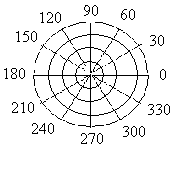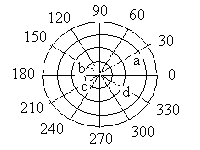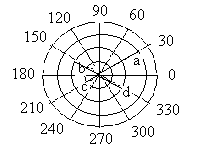Polar Coordinates
 What are Polar Coordinates ? - When you see a plot of data it is most commonly a rectangular plot with a horizontal axis (frequently labeled x) and a vertical axis (labeled y). In this section we are going to introduce a new plotting scheme called a polar plot. Instead of x and y our variables will be the radius from the center of a circle (represented by the letter r) and an angle (represented by some symbol, we will use B). The angle will be generated in the positive direction by rotating a horizontal axis counterclockwise. A sample showing every 30o is shown on the right. The radius, r, should be measured along the line from the center of the circle to a point in the plane. To help the placement of the points polar graph paper usually has a series of concentric circles while are marked with a scale just as you might mark off the x and y axes on a rectangular plot. In addition a number of points have been placed on the figure.
What are Polar Coordinates ? - When you see a plot of data it is most commonly a rectangular plot with a horizontal axis (frequently labeled x) and a vertical axis (labeled y). In this section we are going to introduce a new plotting scheme called a polar plot. Instead of x and y our variables will be the radius from the center of a circle (represented by the letter r) and an angle (represented by some symbol, we will use B). The angle will be generated in the positive direction by rotating a horizontal axis counterclockwise. A sample showing every 30o is shown on the right. The radius, r, should be measured along the line from the center of the circle to a point in the plane. To help the placement of the points polar graph paper usually has a series of concentric circles while are marked with a scale just as you might mark off the x and y axes on a rectangular plot. In addition a number of points have been placed on the figure.
 In locating points using polar coordinates you start along the positive x axis, rotate the axis counterclockwise for positive angles and clockwise for negative angles that then go the proscribed number of units from the origin to the point. In this case positive angles have been marked around the circle. Assume that the rings are 1 unit apart so we can have r values from 0 to 4. Let's look at some points
In locating points using polar coordinates you start along the positive x axis, rotate the axis counterclockwise for positive angles and clockwise for negative angles that then go the proscribed number of units from the origin to the point. In this case positive angles have been marked around the circle. Assume that the rings are 1 unit apart so we can have r values from 0 to 4. Let's look at some points
Locating points using polar coordinates, positive angles and r > 0
- (3, 30o), rotate the positive x axis through a 30o angle, then go to the third circle, point a.
- (2, 150o), rotate the positive x axis through a 150o angle, then go to the second circle, point b.
- (1, 210o), rotate the positive x axis through a 210o angle, then go to the first circle, point c.
- (2, 330o), rotate the positive x axis through a 330o angle, then go to the second circle, point d.
Now lets locate the same points but use negative angles instead of positive ones.
Locating points using polar coordinates, negative angles and r > 0
- (3, -330o), rotate the positive x axis through a -330o angle, then go to the third circle, point a.
- (2, -210o), rotate the positive x axis through a 150o angle, then go to the second circle, point b.
- (1, -150o, rotate the positive x axis through a -150o angle, then go to the first circle, point c.
- (2, -30o, rotate the positive x axis through a -30o angle, then go to the second circle, point d.
 Finally, what if r is negative? In this case you rotate through the specified angle but instead of going from the center along the terminal line you extend the terminal line backwards and go the specified number of units in the opposite direction. Confusing, let's look at the same points with positive angles and negative values for r.
Finally, what if r is negative? In this case you rotate through the specified angle but instead of going from the center along the terminal line you extend the terminal line backwards and go the specified number of units in the opposite direction. Confusing, let's look at the same points with positive angles and negative values for r.
- (-3, 210o, rotate the positive x axis through a 210o angle, then extent the line through the origin into the first quadrant to the third circle, point a.
- (-2, 330o, rotate the positive x axis through a 330o angle, then extend the line through the origin into the second quadrant and go to the second circle, point b.
- (-1, 30o, rotate the positive x axis through a 30o angle, then extend the line through the origin into the third quadrant and go to the first circle, point c.
- (-2, 150o, rotate the positive x axis through a 150o angle, then extend the line through the origin into the fourth quadrant and go to the second circle, point d.
 What are Polar Coordinates ? - When you see a plot of data it is most commonly a rectangular plot with a horizontal axis (frequently labeled x) and a vertical axis (labeled y). In this section we are going to introduce a new plotting scheme called a polar plot. Instead of x and y our variables will be the radius from the center of a circle (represented by the letter r) and an angle (represented by some symbol, we will use B). The angle will be generated in the positive direction by rotating a horizontal axis counterclockwise. A sample showing every 30o is shown on the right. The radius, r, should be measured along the line from the center of the circle to a point in the plane. To help the placement of the points polar graph paper usually has a series of concentric circles while are marked with a scale just as you might mark off the x and y axes on a rectangular plot. In addition a number of points have been placed on the figure.
What are Polar Coordinates ? - When you see a plot of data it is most commonly a rectangular plot with a horizontal axis (frequently labeled x) and a vertical axis (labeled y). In this section we are going to introduce a new plotting scheme called a polar plot. Instead of x and y our variables will be the radius from the center of a circle (represented by the letter r) and an angle (represented by some symbol, we will use B). The angle will be generated in the positive direction by rotating a horizontal axis counterclockwise. A sample showing every 30o is shown on the right. The radius, r, should be measured along the line from the center of the circle to a point in the plane. To help the placement of the points polar graph paper usually has a series of concentric circles while are marked with a scale just as you might mark off the x and y axes on a rectangular plot. In addition a number of points have been placed on the figure.
 In locating points using polar coordinates you start along the positive x axis, rotate the axis counterclockwise for positive angles and clockwise for negative angles that then go the proscribed number of units from the origin to the point. In this case positive angles have been marked around the circle. Assume that the rings are 1 unit apart so we can have r values from 0 to 4. Let's look at some points
In locating points using polar coordinates you start along the positive x axis, rotate the axis counterclockwise for positive angles and clockwise for negative angles that then go the proscribed number of units from the origin to the point. In this case positive angles have been marked around the circle. Assume that the rings are 1 unit apart so we can have r values from 0 to 4. Let's look at some points
 Finally, what if r is negative? In this case you rotate through the specified angle but instead of going from the center along the terminal line you extend the terminal line backwards and go the specified number of units in the opposite direction. Confusing, let's look at the same points with positive angles and negative values for r.
Finally, what if r is negative? In this case you rotate through the specified angle but instead of going from the center along the terminal line you extend the terminal line backwards and go the specified number of units in the opposite direction. Confusing, let's look at the same points with positive angles and negative values for r.